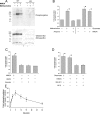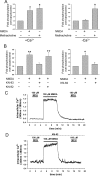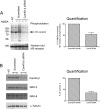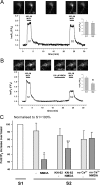N-methyl-D-aspartate receptors mediate the phosphorylation and desensitization of muscarinic receptors in cerebellar granule neurons
- PMID: 19332541
- PMCID: PMC2719353
- DOI: 10.1074/jbc.M901031200
N-methyl-D-aspartate receptors mediate the phosphorylation and desensitization of muscarinic receptors in cerebellar granule neurons
Abstract
Changes in synaptic strength mediated by ionotropic glutamate N-methyl-D-asparate (NMDA) receptors is generally considered to be the molecular mechanism underlying memory and learning. NMDA receptors themselves are subject to regulation through signaling pathways that are activated by G-protein-coupled receptors (GPCRs). In this study we investigate the ability of NMDA receptors to regulate the signaling of GPCRs by focusing on the G(q/11)-coupled M(3)-muscarinic receptor expressed endogenously in mouse cerebellar granule neurons. We show that NMDA receptor activation results in the phosphorylation and desensitization of M(3)-muscarinic receptors through a mechanism dependent on NMDA-mediated calcium influx and the activity of calcium-calmodulin-dependent protein kinase II. Our study reveals a complex pattern of regulation where GPCRs (M(3)-muscarinic) and NMDA receptors can feedback on each other in a process that is likely to influence the threshold value of signaling networks involved in synaptic plasticity.
Figures






Similar articles
-
NMDA-receptor regulation of muscarinic-receptor stimulated inositol 1,4,5-trisphosphate production and protein kinase C activation in single cerebellar granule neurons.J Neurochem. 2004 Jun;89(6):1537-46. doi: 10.1111/j.1471-4159.2004.02458.x. J Neurochem. 2004. PMID: 15189357
-
Calcium influx via ionotropic glutamate receptors causes long lasting inhibition of metabotropic glutamate receptor-coupled phosphoinositide hydrolysis.Neurochem Int. 1998 Sep;33(3):263-70. doi: 10.1016/s0197-0186(98)00030-8. Neurochem Int. 1998. PMID: 9759922
-
Mechanisms underlying developmental changes in the expression of metabotropic glutamate receptors in cultured cerebellar granule cells: homologous desensitization and interactive effects involving N-methyl-D-aspartate receptors.Mol Pharmacol. 1993 Nov;44(5):981-9. Mol Pharmacol. 1993. PMID: 7902531
-
N-methyl-D-aspartate and TrkB receptor activation in cerebellar granule cells: an in vitro model of preconditioning to stimulate intrinsic survival pathways in neurons.Ann N Y Acad Sci. 2003 May;993:134-45; discussion 159-60. doi: 10.1111/j.1749-6632.2003.tb07522.x. Ann N Y Acad Sci. 2003. PMID: 12853306 Free PMC article. Review.
-
Molecular mechanisms associated with long-term consolidation of the NMDA signals.Life Sci. 2000 Jun 16;67(4):335-64. doi: 10.1016/s0024-3205(00)00632-9. Life Sci. 2000. PMID: 11003045 Review.
Cited by
-
Cholinergic connectivity: it's implications for psychiatric disorders.Front Cell Neurosci. 2013 May 3;7:55. doi: 10.3389/fncel.2013.00055. eCollection 2013. Front Cell Neurosci. 2013. PMID: 23653591 Free PMC article.
-
Transfection techniques for neuronal cells.J Neurosci. 2010 May 5;30(18):6171-7. doi: 10.1523/JNEUROSCI.0183-10.2010. J Neurosci. 2010. PMID: 20445041 Free PMC article. Review. No abstract available.
-
Highly efficient method for gene delivery into mouse dorsal root ganglia neurons.Front Mol Neurosci. 2015 Feb 2;8:2. doi: 10.3389/fnmol.2015.00002. eCollection 2015. Front Mol Neurosci. 2015. PMID: 25698920 Free PMC article.
-
Optogenetic reporters: Fluorescent protein-based genetically encoded indicators of signaling and metabolism in the brain.Prog Brain Res. 2012;196:235-63. doi: 10.1016/B978-0-444-59426-6.00012-4. Prog Brain Res. 2012. PMID: 22341329 Free PMC article. Review.
-
NMDA receptor-dependent GABAB receptor internalization via CaMKII phosphorylation of serine 867 in GABAB1.Proc Natl Acad Sci U S A. 2010 Aug 3;107(31):13924-9. doi: 10.1073/pnas.1000909107. Epub 2010 Jul 19. Proc Natl Acad Sci U S A. 2010. PMID: 20643921 Free PMC article.
References
Publication types
MeSH terms
Substances
Grants and funding
LinkOut - more resources
Full Text Sources
Molecular Biology Databases

